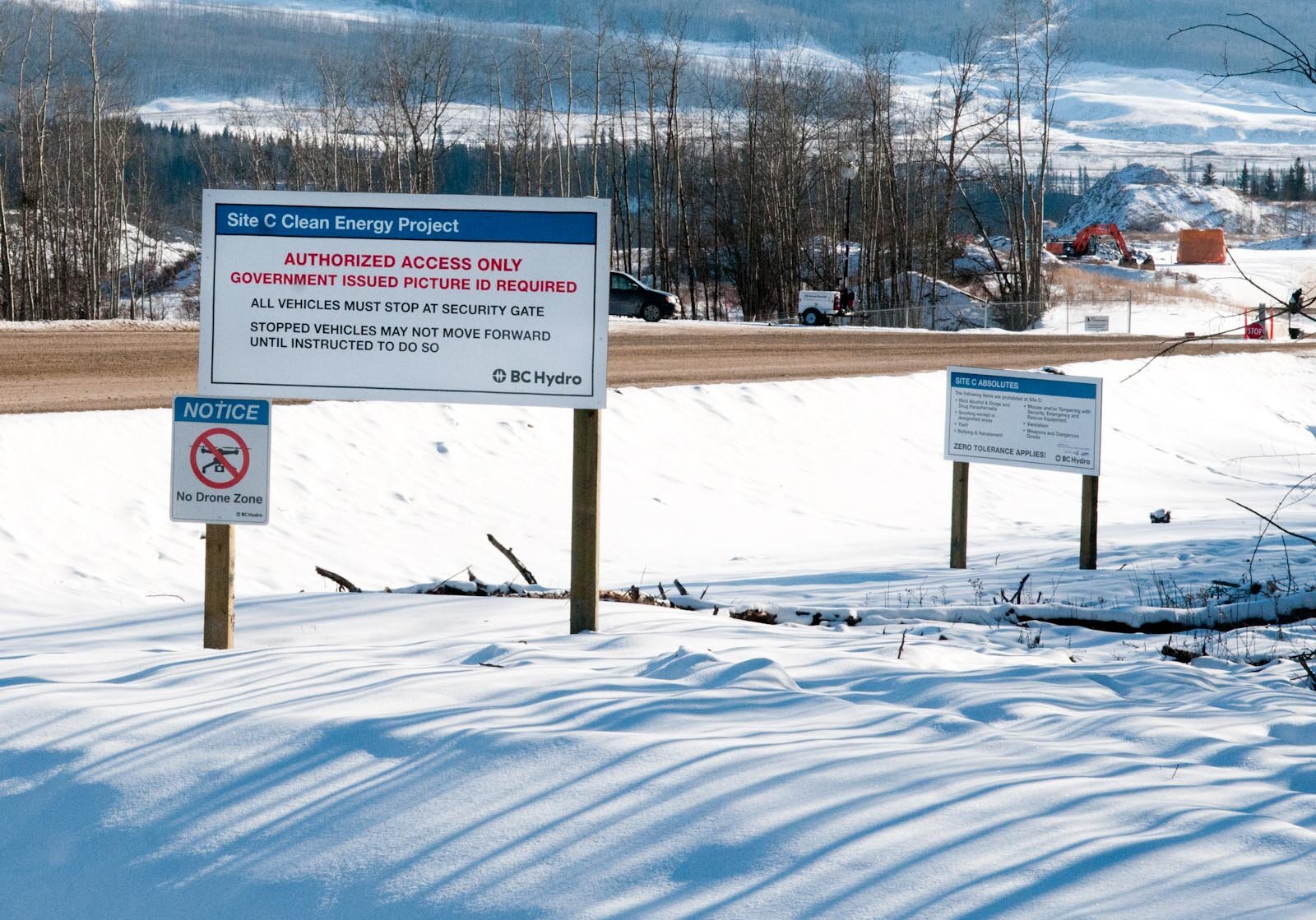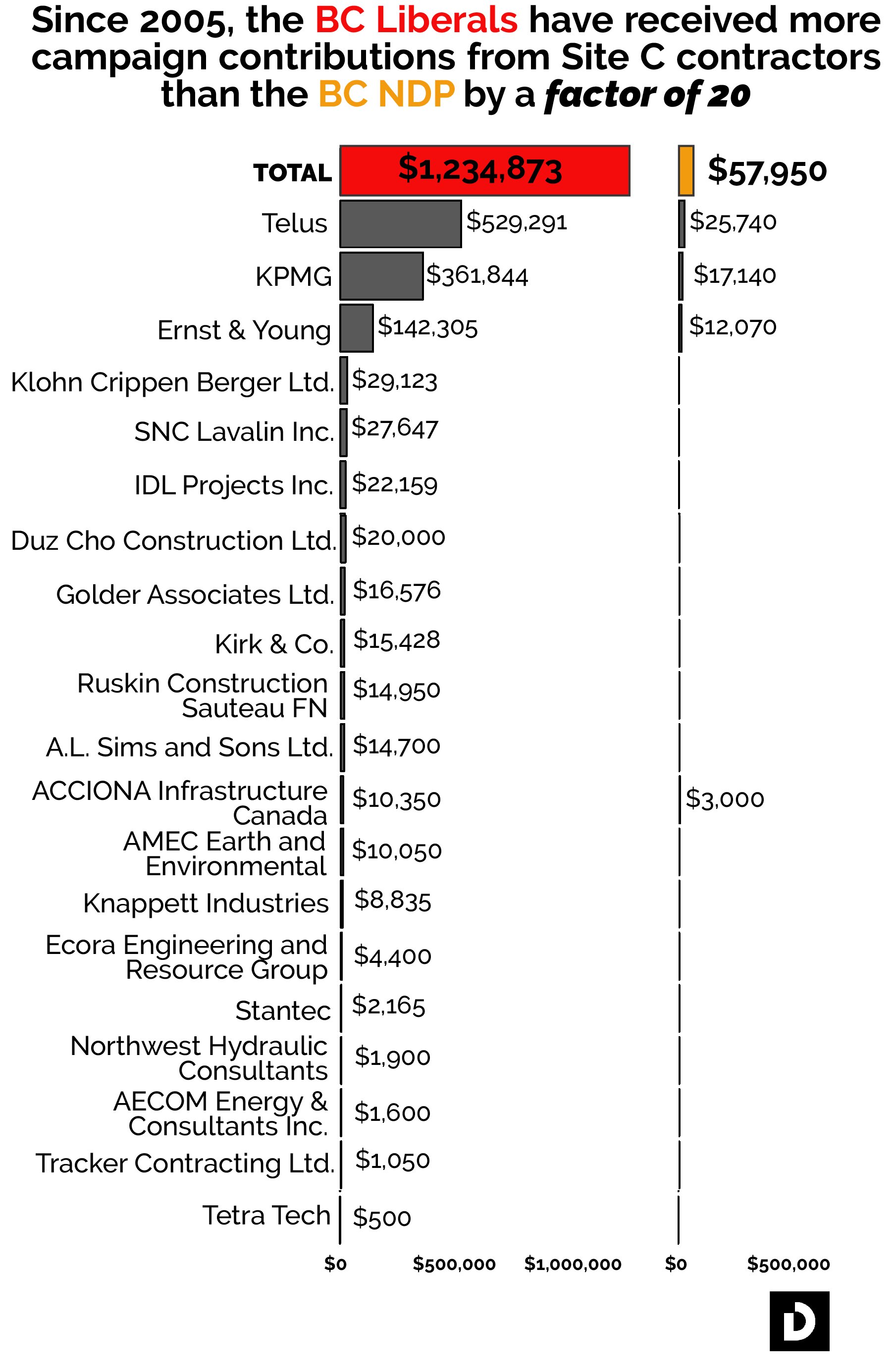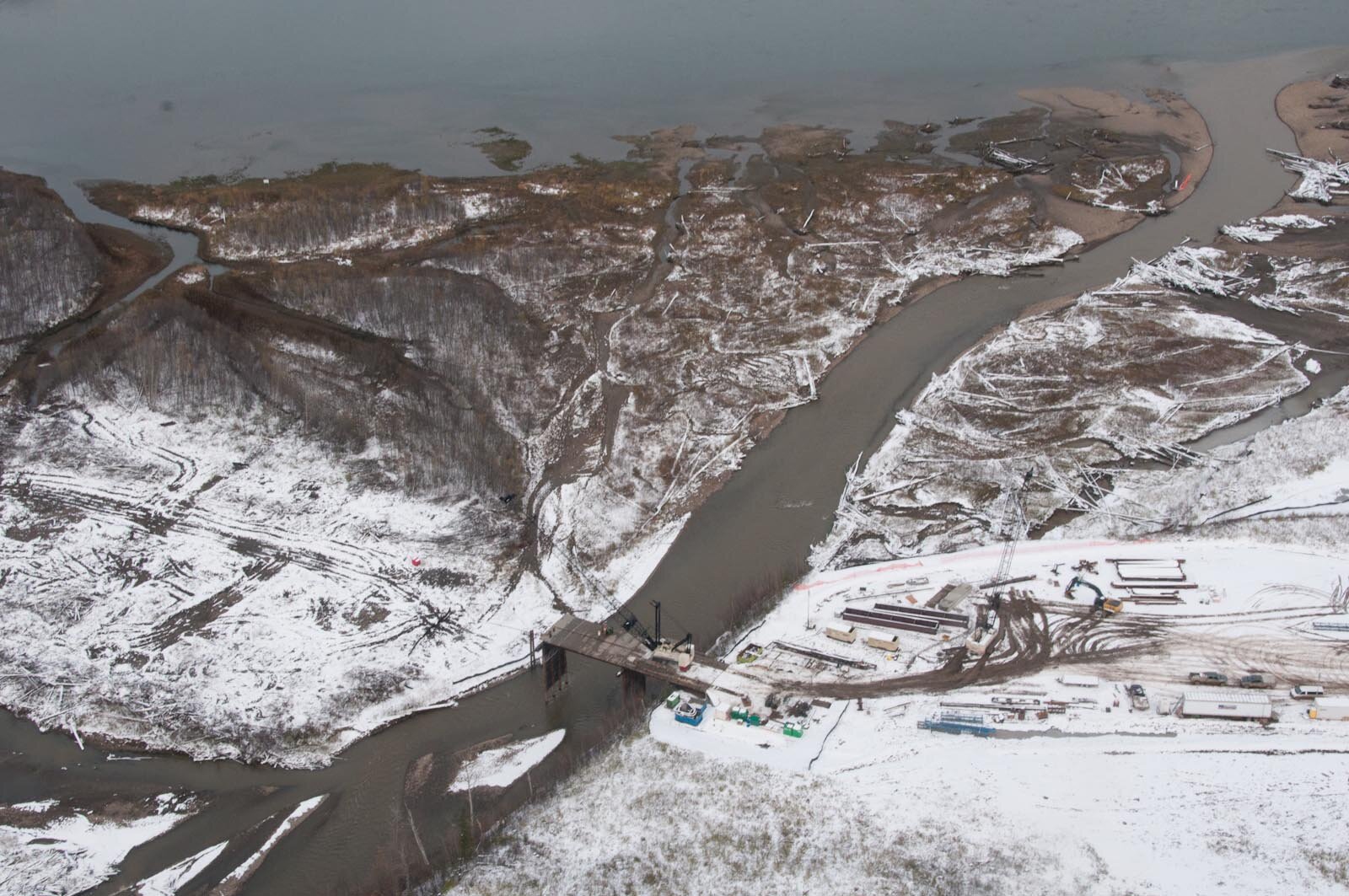How Site C entered the murky world of political donations and lobbying loopholes
We dug deeper into companies working on B.C.‘s megaproject and their ties to the Liberal government

If the Site C dam is ever completed, it’ll be the most expensive public project in British Columbian history. BC Hydro, which is building the dam, estimates that nearly $9 billion will have been spent by the time it’s completed in 2024.
The provincial Crown corporation has already spent or committed more than $4 billion in contracts to private companies and partnerships. It will take BC Hydro’s customers more than 70 years from the dam’s completion date to cover these costs — longer if it goes over budget.
So who’s getting these billions? At this point, there’s been no comprehensive, publicly available BC Hydro list of who has won contracts and how much money they’re being paid.
That’s why we dug deeper and compiled a list of Site C vendors, providing mainly services or construction, for you to assess:
Featuring 51 companies, subsidiaries, partnerships and individuals, our list is incomplete, gleaned from government and BC Hydro press releases and multiple Freedom of Information searches, including this one filed by journalist Jonny Wakefield last year.
We learned that, for many of the companies winning contracts, making political donations and paying lobbyists are an accepted way of doing business. It’s important to understand what’s going on behind the scenes — even if no laws are being broken — so the public can protect itself from paying any more than needed.
It’s our money, after all.
How many contractors donated to the BC Liberals?
Searching Elections BC records, we found that 20 of the 51 corporate entities on our list — including company subsidiaries and parent companies of contractors — made contributions to the ruling BC Liberal Party between 2005 and 2017. Their contributions range from as low as $1,050 (from Tracker Contracting), to as high as $529,291 (from Telus).

Just four of the 20 — all larger companies — donated to the BC NDP. Of the total Telus donations, just over $25,000 was given to the opposition. Ernst & Young and KPMG followed the same pattern, donating primarily to the BC Liberals, with smaller sums going to the NDP. We found just one donation to the Green Party: $500 given by the Doig River First Nation, which owns Doig River Timber.
How are these donations possible? Contrary to most of North America, there are no limits on political donations in B.C. But in the United States, it’s long been illegal for companies or individuals with federal contracts (or those who are negotiating them) to make donations to federal parties or candidates.
Across most of the rest of Canada, companies doing government business can’t make political donations because union and corporate donations are banned.
What about donations from company executives?
Party donations don’t stop at the company level. A total of 11 executives from six different companies appear to have made personal donations to the BC Liberal Party between 2005 and now.
Number one on the list is Vancouver-based Kirk & Company, BC Hydro’s lead Site C communications agency. Their contract began in 2007 and, according to the company website, its work is ongoing. Kirk & Co., which designed and executed the Site C consultation strategy, donated $15,428 to the BC Liberals between 2006 and 2016.
On top of that, three of the company’s top executives gave a total of $10,608 in their own names; this doesn’t include donations to the BC Liberals by Kirk & Co. senior associate Mike McDonald. According to the company website, McDonald led B.C. Liberal Premier Christy Clark’s winning leadership campaign team in 2011, guided her transition team and then served as her chief of staff. McDonald also led Clark's successful 2013 election campaign. He’s part of her campaign team this time around, too, the Vancouver Sun reported. Through his company, Rosedeer Strategies Inc., McDonald donated just under $5,000 to the BC Liberals between 2015 and 2016.
How are these contracts being awarded?
Among the 51 companies and contractors in our review, there are two kinds of contracts: open bids, where companies must compete with other parties in an open process, and contracts awarded directly by BC Hydro without an open competition.
In theory, open bidding ensures that some combination of the lowest bid and most qualified companies get the work.

But an open bid process doesn’t guarantee that the lowest bid will win the contract. The biggest, single publicly announced contract we found — valued at $1.75 billion — is a case in point. The contract, which is for the main civil works project to build the earth-fill dam and more, was won by a joint partnership made up of Spain’s ACCIONA, South Korea’s Samsung C&T and Alberta’s Petrowest Corp. To date, BC Hydro still hasn’t disclosed what the lowest bid was, despite an FOI request filed in November 2015 by Business in Vancouver.
What’s more, about half the contracts were directly awarded to BC Hydro’s chosen provider without an open, competitive process. According to the procurement rules of the 2013 New West Partnership Trade Agreement (NWPTA), Crown corporations awarding service and construction contracts over $100,000 must go to open, “non-discriminatory” bids. But we found that, despite the $100,000 threshold for triggering open bids, there are many loopholes. As our list of contracts shows, in many cases, the $100,000 transparency threshold can be waived.
What are the rules for giving out contracts to First Nation-involved joint ventures?
More than half of all direct award contracts — 14 in our review — have an Aboriginal partnership or joint venture component. By November 2016, BC Hydro estimated that about 200 Indigenous workers were employed by the project and that the Crown corporation had committed “more than $100 million in Site C procurement opportunities to Aboriginal companies, in addition to the procurement opportunities offered by our contractors, who also directly engage Aboriginal companies.”
At the same time, there appears to be waning opposition to Site C by numerous First Nations governments in the Peace Region. But it’s unclear whether this is a direct result of rising employment and procurement opportunities from the project. At least five First Nations (three Treaty 8 signatories among them) are represented on our list, including the Saulteau, Doig River, Halfway River and the McLeod Lake Indian Band. Then there are multiple Impact Benefit Agreements that have been signed with local First Nations — the terms of which are secret. In a press release announcing the recent Impact Benefit Agreement between BC Hydro and the Doig River First Nation (a Treaty 8 First Nation), for example, the agreement includes “cash payments, procurement opportunities, [and] the selection and transfer of provincial Crown lands.”
The list of exceptions that allow the waiving of thresholds requiring open bids is a long one. Exceptions can be made when there’s unforeseeable urgency, a need for critical expertise, only one applying party, or in the case of affirmative action programs for disadvantaged groups.
What are the rules for former provincial politicians-turned-Site C lobbyists?
At least six companies on the list have lobbied the B.C. government. Two former cabinet ministers and one former senior public servant worked as lobbyists for companies that have received Site C contracts, including former Energy, Mines and Petroleum Resources Minister Blair Lekstrom, and Lands and Agriculture Minister Pat Bell.
Records from the Office of the Registrar of Lobbyists for B.C. show that Lekstrom, a former Peace River South MLA, lobbied for BC Hydro work on behalf of Duz Cho Construction Ltd., a company owned by the McLeod Lake Indian band and the holder of a contract. (In 2016, Lekstrom was fined by the Office of the Registrar of Lobbyists for B.C. for failing to register as a lobbyist.)
“We don’t monitor or keep track of members after they’ve left, so our system is complaints-driven,”
B.C. cabinet ministers are free to begin lobbying on behalf of clients as soon as they leave office, though the Members’ Conflict of Interest Act says cabinet can’t “award or approve a contract with, or grant a benefit to, a person on whose behalf a former member of the Executive Council or former parliamentary secretary” has lobbied within two years of leaving government.
This is far out of step with the Federal Lobbying Act, which prohibits former Members of Parliament, senators and senior ranks of the civil service from lobbying any federal government agencies for five years, post-employment.
A spokesperson for B.C.’s Office of the Conflict of Interest Commissioner said it doesn’t actively enforce the two-year rule.
“We don’t monitor or keep track of members after they’ve left, so our system is complaints-driven,” the office said. “So if someone thought a minister had gone back and was lobbying incorrectly, it would have to be brought to our office to enforce.”
This investigation was completed with files from Francesca Fionda and Jon von Ofenheim. Data interactive and graphic by Caitlin Havlak. This story is part of collaborative project by Discourse Media and The Tyee. Read reporter Zoë Ducklow's introduction to the project here. Read more about the business case for Site C here.
